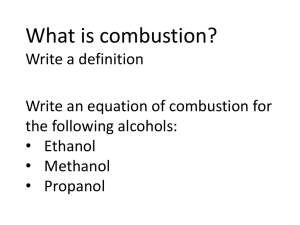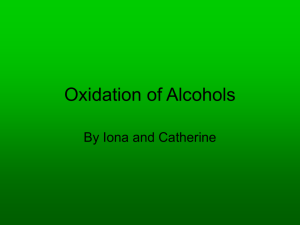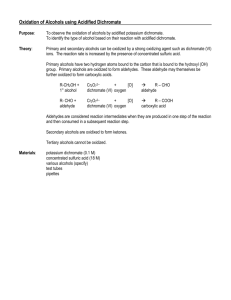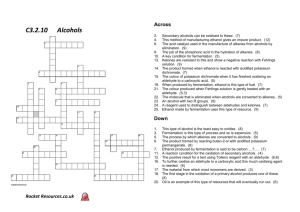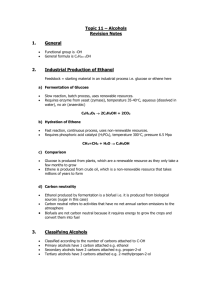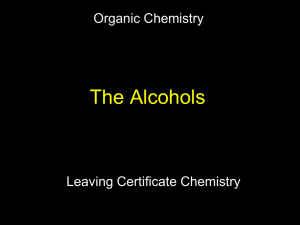Combustion & Oxidation of Alcohols Chemistry Presentation
advertisement
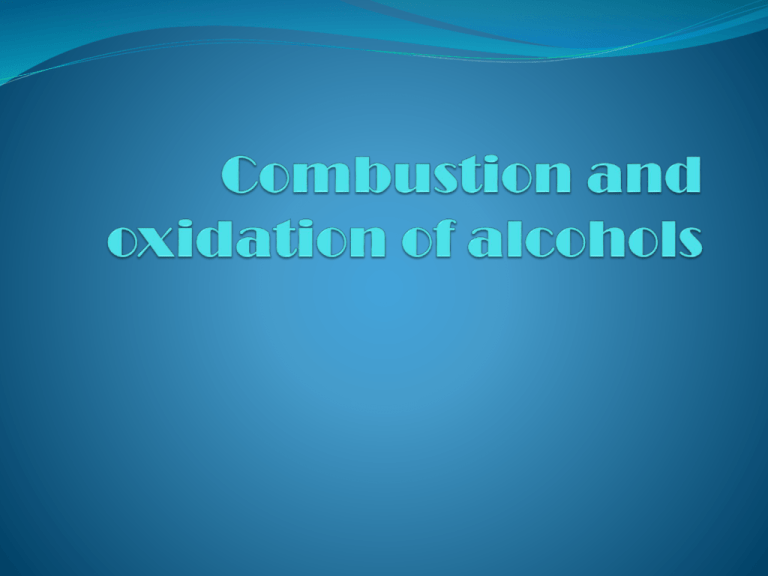
Starter When 50cm3 of ethanol is mixed with 50cm3 of water in a 100cm3 measuring cylinder, the total volume is only 98cm3. Can you explain why there is 2cm3 of liquid ‘missing’? When water and ethanol are mixed, hydrogen bonds form between the molecules. This draws the molecules closer together than in pure ethanol or pure water, reducing the volume Learning objectives • Describe the combustion of alcohols. • Describe the oxidation of primary and secondary alcohols. • Outline the resistance to oxidation of tertiary alcohols. Combustion of alcohols Demonstration – combustion of ethanol What are the products of the combustion of ethanol in a plentiful supply of oxygen? Carbon dioxide and water Write and balance the equation C2H5OH + 3O2 2CO2 + 3H2O Oxidation of alcohols Using a selection of alcohols, we are going to test to see what happens when we oxidise alcohols Instructions 1. Put 10 drops of acidified potassium dichromate into the bottom of each test tube (one for each alcohol you are testing) 2. Add two drops of alcohol to the test tube (label with the alcohol name) 3. Observe the test tubes over the next 15 minutes and note down any observations you see Oxidation of alcohols Oxidation of alcohols Primary and secondary alcohols can be oxidised using an oxidising agent e.g. A solution containing acidified dichromate ions (H+/Cr2O72-) This is made using sulfuric acid and potassium dichromate During the reaction, the acidified potassium dichromate changes from orange to green Primary alcohols Gentle heating Oxidises to produce an ALDEHYDE (functional group -CHO) The product must be distilled off straight away otherwise... Primary alcohols Stronger heating Complete oxidation forming a CARBOXYLIC ACID (-COOH) When making a carboxylic acid, it is heated under REFLUX before distilling off the product Reflux is the continual boiling and condensing of a reaction mixture to ensure that the reaction takes place without the flask boiling dry Secondary alcohols Oxidised to produce ketones (C-CO-C) Cannot be oxidised further Tertiary alcohols Resistant to oxidation The oxidising agent should remain orange in colour Exam questions Can you draw structural isomers of C4H9OH that are alcohols. What products are formed when each isomer is heated in an excess of acidified potassium dichromate? Remember: PRIMARY - aldehyde, then carboxylic acid SECONDARY - ketone TERTIARY - no reaction Questions Page 153 – complete the questions Homework Exam questions on the wiki
